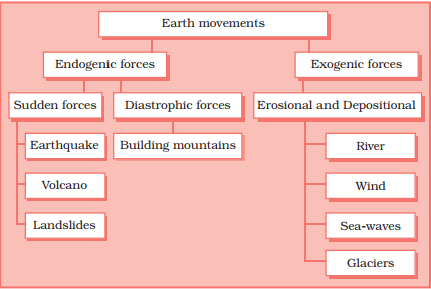UPSC Exam Preparation: NCERT Notes: Geography – Inside Our Earth.
Our Changing Earth Notes
Our Changing Earth

Our Changing Earth (UPSC Notes):- Download PDF Here
- Lithospheric Plates: The lithosphere broken into a number of plates is known as the Lithospheric plates.
- These plates move around very slowly – just a few millimetres each year.
- This is because of the movement of the molten magma inside the earth.
- The movement of these plates causes changes on the surface of the earth.
- The earth movements are divided based on the forces that cause them on the basis of the forces which cause them
- Endogenic forces: The forces which act in the interior of the earth.
Endogenic forces sometimes produce abrupt movements due to which earthquakes and volcanoes occur and cause mass destruction over the surface of the earth and at the other times to produce slow movements. - Exogenic forces: The exogenic forces work on the surface of the earth.
- Endogenic forces: The forces which act in the interior of the earth.
- Volcano: It is an opening or a vent in the earth’s crust through which molten material erupts.
- Earthquakes: Lithospheric plates move, the surface of the earth vibrates. The vibrations can travel all around the earth. These vibrations are called earthquakes.
- Focus: The place in the crust where the movement starts is called the focus.
- Epicentre: The place on the surface above the focus is called the epicentre.
Major Land Forms
- The landscape is being continuously worn away by two processes,
- Weathering: the breaking up of the rocks on the earth’s surface is called weathering
- Erosion: the wearing away of the landscape by different agents like water, wind and ice is called erosion
- Work of a River: When the river tumbles at a steep angle over very hard rocks or down a steep valley side it forms a waterfall.
- Work of Sea Waves: The coastal landforms are formed due to the erosion and deposition of the sea waves.
- Work of Ice: Glaciers are “rivers” of ice which too erode the landscape by bulldozing soil and stones to expose the solid rock below.
- Work of wind: An active agent of erosion and deposition in the deserts is wind. In deserts, you can see rocks in the shape of a mushroom, commonly called mushroom rocks.
Our Changing Earth (UPSC Notes):- Download PDF Here
Also, see:
| Structure of the earth |
| Inside our earth |
| Major landforms of the earth |
Comments